#symbol of Persia
Text


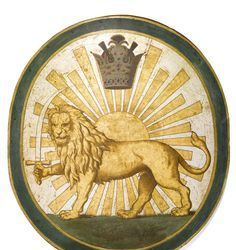
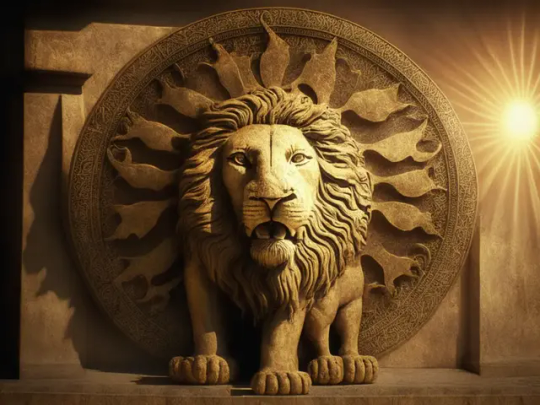
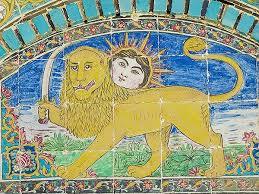

Okay, this is a Persian symbol, and every time I think of Cersei x Oberyn or Elia x Jaime or Myrcella x Trystan pairings I remember this symbol.
Lion and Sun, imagine a dynasty of Lannisters and Martells with a flag like that!
Did you know the mane of a lion represents the flares of the sun in Persian?
Sun is Life! And the Lion is the protector of the realm!
#cersei x oberyn#Jaime x Elia#Myrcella x Trystan#house lannister#house martell#asoiaf#a song of ice and fire#cersei lannister#oberyn martell#prince oberyn#ff#fanfic#fanfic prompt#lannister x martell dynasity#lannister x martell flag#Perisan symbol#persian#persian flag#symbol of Persia#cersei lannister x oberyn Martell#Iranian flag
26 notes
·
View notes
Text
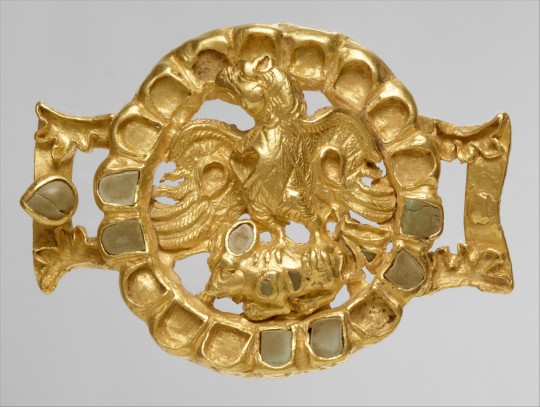
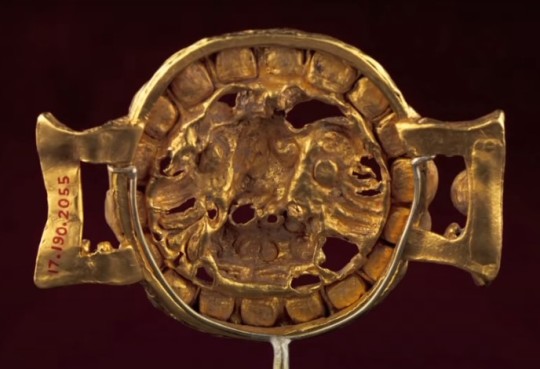
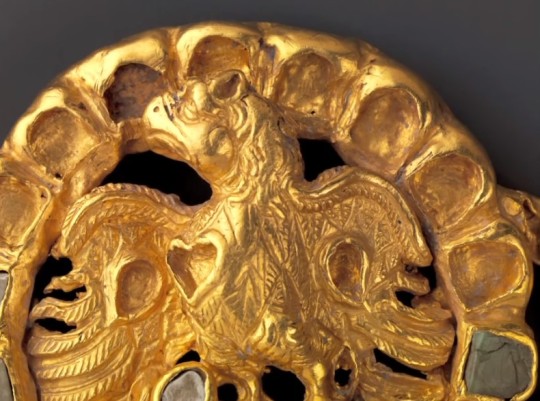
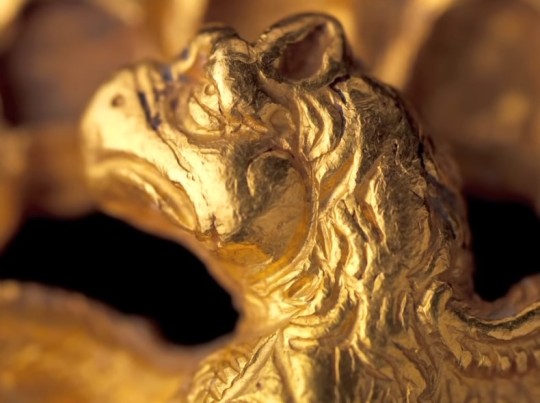
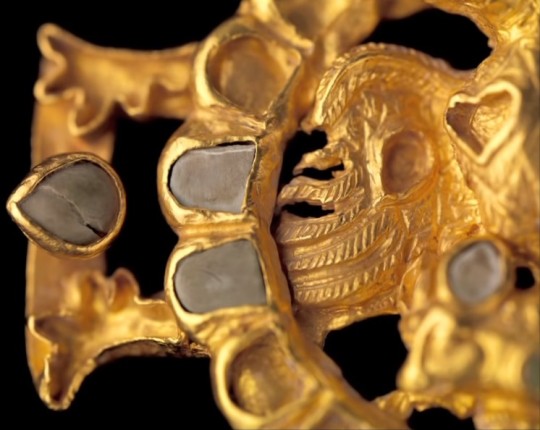

Gold clasp of eagle, possibly belonging to the House of Karen, 1st-2nd C. CE. Found in Nahavand. The House of Karen seems to have been descended from the Parni, who were themselves an offshoot of the Scythians. Ernst Herzfeld wrote that this item probably belonged to their house.
"House of Karen (Middle Persian: Kārēn; Parthian: 𐭊𐭓𐭍𐭉, romanized: Kārēn; Persian: کارن, romanized: Kārin or Kāren), also known as Karen-Pahlav (Kārēn-Pahlaw) was one of the Seven Great Houses of Iran during the rule of Parthian and Sassanian Empires. The seat of the dynasty was at Nahavand, about 65 km south of Ecbatana (present-day Hamadan, Iran). Members of House of Karen were of notable rank in the administrative structure of the Sassanian empire in multiple periods of its four century-long history.
The Karens, Karan-Vands, Qarinvand dynasty or Karen-Pahlevi as they are also called, claimed descent from Karen, a figure of folklore and son of the equally mythical Kaveh the Blacksmith. Their historical origin however may be that the Karens, along with the House of Mihran, were descended from the Arsacids. According to Movses Khorenatsi, this descent was via one of the three sons of Phraates IV, also named Karen. The fact that Karen may also have been among the family names of the Arsacid dynasty may give credence to this theory.
The first verified reference to the Karenas was during the Arsacid era, specifically as one of the feudal houses affiliated with the Parthian court. In this they were similar to the House of Suren, the only other attested feudal house of the Parthian period. Following the conquest of the Parthians, the Karenas allied themselves with the Sassanids, at whose court they were identified as one of the so-called "Parthian clans". The Armenian Kamsarakan family was a branch of the House of Karen."
-taken from Wikipedia
youtube
#scythian#iranian#ancient persia#ancient history#history#art#antiquities#museums#archaeology#heart symbol#Youtube
206 notes
·
View notes
Text



The blind owl by Sadeq Hedayat
“His symbolism of women in this book is illuminating. Eyes and faces are important, because woman is associated with creative reflections. The writer who is seeking confirmation of identity is desperate for the eyes or the face that can respond to him in order to confirm his being. When the narrator can not find such confirmation his life is forfeit. At this point, the ethereal woman's face and eyes connect woman with death. The problem of woman now becomes problem of existence and meaninglessness.”
4 notes
·
View notes
Text
A Good Omen
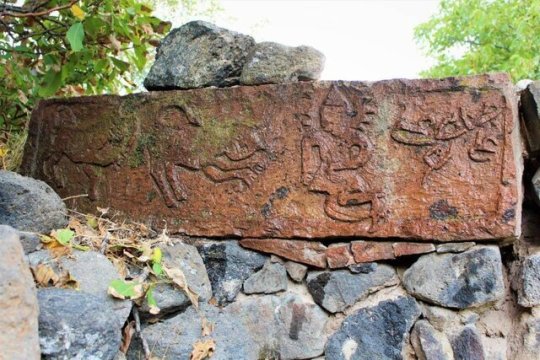
Just the same an ancient persian sword was found in Krasnodar(see in a old post of mine https://ashitakaxsan.tumblr.com/post/698956033583972352/ancient-iranian-sword-unearthed-in-russia )now an other significant discovery opens up to us a perspective,to what worthy events have taken place long ago.
Namely iranian Inscriptions were discovered in a ruined mosque,in a small village in Armenia,that can help trace the history of the Iranian lion symbol back several hundred years,it’s what a member of Iran’s Research Institute of Cultural Heritage and Tourism has said.
It turns out that Armenian inscriptions place the history of the lion symbol in Iranian petroglyphs 600 years earlier than archaeologists originally thought, ISNA quoted Morteza Rezvanfar as saying on Friday.
In one of these Persian inscriptions, a lion is engraved with a sword in hand next to the name of Imam Ali (AS), he added.
According to historical documents, this motif dates back to the time of the Qajar king Fath Ali Shah who reigned from 1797 to 1834, but these newly discovered inscriptions may push that date back over 600 years, he explained.
In addition to the lion and sun symbol, which dates back thousands of years, the first image of a lion holding a sword in inscriptions discovered in Iran, dates back to Qajar-era (1789-1925), and before that, the lion symbol have always had its feet on the ground, he noted.
Iran, also known as Persia, historic region of southwestern Asia that is only roughly coterminous with modern Iran. The term Persia was used for centuries, chiefly in the West, to designate those regions where the Persian language and culture predominated, but it more correctly refers to a region of southern Iran formerly known as Persis, alternatively as Pars or Parsa, modern Fars.
My little say:
The nation of Persia,are the real natives of the land,the Persians are the Ancestores of todays Iranians,their origin has nothing to do with “Indo-European”,because the Indo-European theory is a severe fabrication made by weird Western intellectuals. As the iranian artifact found there this just says:if any nasty entity attempts there to pull something it will find Iran opposing,to any scheme.
Source:https://www.tehrantimes.com/news/484342/Inscriptions-found-in-Armenia-may-push-back-history-of-Iran-s
#Iran#Iranian archaeologists#Iranian petroglyphs#Armenia#Ancient Persia#lion symbol of Iran#Tehran#iranian artifacts in Caucasus#Caucasus#Hayastan#Indoeuropean hoax#Tehrantimes
1 note
·
View note
Text
Word List: Fashion History
to try to include in your poem/story (pt. 2/3)
Exomis - a short, asymmetrical wrap garment pinned at the left shoulder, worn by men in Ancient Greece
Eye of Horus - or Wedjat eye, is an ancient Egyptian symbol that represents the eye of the falcon-headed god Horus and symbolizes healing and regeneration and was often worn for protection
Faience - a man-made ceramic material that was often used in ancient Egypt to make jewelry and devotional objects; it is usually a blue color
Falling Band - a flat and broad white collar often with lace on the edges, worn by men and women in the 17th century
Fibula - served as a pin to both hold garments together and to show status of those with prestige or power within society; was popular in Greek culture
Fichu - a triangular shawl, usually worn by women, draped over the shoulders and crossed or fastened in the front
Fontange - a linen cap with layers of lace and ribbon, worn flat and pinned to the back of the head
French Hood - a rounded headdress for women that was popular in the 16th century (from 1540)
Frock Coat - a collared man’s coat worn through the eighteenth to the twentieth century; rose to prominence mainly in the nineteenth century, especially Victorian England; characterized as a knee-length overcoat, buttoned down to the waist, that drapes over the lower half of the body like a skirt
Frogging - ornamental braid or cording that can function as a garment closure, or be solely decorative
Gabled Hood - a woman’s headdress that is wired to create a point at the top of the head and has fabric that drapes from the back of the head
Gigot Sleeve - a sleeve that was full at the shoulder and became tightly fitted to the wrist; also called leg-of-mutton sleeve
Guipure Lace - a type of continuous bobbin lace made without a mesh ground; its motifs are connected by bridges or plaits
Himation - a rectangular cloak wrapped around the body and thrown over the left shoulder worn by the ancient Greeks
Huipilli/Huipil - a woven rectangular shirt worn by women in Central America beginning in ancient times
Jerkin - a close-fitting men’s jacket, often worn for warmth, sometimes without sleeves; worn over a doublet in the 16th and 17th centuries
Justaucorps - a long-sleeved, knee-length coat worn by men after 1666 and throughout the 18th century
Kaftan - (also caftan) is an ancient garment, which originated in ancient Persia but then spread across Central and Western Asia; a kind of robe or tunic that was worn by both men and women
Katazome (stencil printing) - a traditional Japanese method for printing designs onto fabric using a stencil and paste-resist dyes
Kaunakes - one of the earliest forms of clothing; made from goat or sheep’s wool and meant to be worn around the waist like a skirt, it is recognizable by its fringe detailing
Kente - a Ghanaian strip woven textile that has striped patterns and bright colors with corresponding meanings
Knickerbockers - or “knickers” are full or baggy trousers gathered at the knee or just below and usually fastened with either a button or buckle; were initially worn by men in the late 19th century and gradually became part of women’s fashion; the garment was usually worn as sportswear and became especially popular among golfers and female cyclists, hence the term “pedal pushers”
Kohl - a black material made out of minerals such as galena and used for eyeliner and eye protection in ancient Egypt
Labret - a type of lip-piercing worn by various cultures to indicate wealth, prosperity and beauty
Love Lock - a lock of hair from the nape of the neck hanging over the chest to show romantic attachment; it was a popular hairstyle between 1590-1650
Lurex - a shiny synthetic fiber made of aluminum-coated plastic with a glittering metallic sheen
Mantua - a jacket-like bodice with pulled back overskirt that bustled in the back, often in elaborately patterned fabric, first worn in the 17th century
Medici Collar - a collar that stands upright on the back of the neck and opens in the front; this type of ruff was introduced to France by Marie de’ Medici in the 16th century, taking her name two centuries later
Moccasins - a type of soft animal skin shoe that were worn by Indians in North America
Muff - a tubular padded covering of fur or fabric, into which both hands are placed for warmth
Mule - a backless shoe
Muslin - a simple plain-weave textile made out of cotton and available in varying weights and finishes; historically, there were also varieties of muslin in silk and wool
Needle Lace -often known as “needlepoint lace”; is a term referring to the technique in which the lace is made of entirely needle work; it developed in the 15th century and then became very popular throughout the 16th century
Nemes Headdress - starched, striped linen headdress that draped on the shoulders and had a tail at center back worn only by royals in ancient Egypt
Panes/Paning - a method of decoration using long parallel strips of fabric arranged to reveal a contrasting fabric underneath that was fashionable from the 15th-17th centuries
Panniers - an under-structure used in eighteenth-century fashion that created a shape wide at the sides and flat at the front and back
Pantalettes - (also referred to as pantaloons) are loose, pants-like undergarments that covered women’s lower halves in the late 18th and early 19th century
Particolored - the combination of different colors within the same garment along the vertical axis
Passementerie - an additional accent or embellishment in silk or metallic threads, such as an embroidered braid, tassel or fringe
Pattens - wooden-soled platform over-shoes, which were commonly worn from the 14th century to the 18th century
If any of these words make their way into your next poem/story, please tag me, or leave a link in the replies. I would love to read them!
More: Fashion History
More: Word Lists
#word list#writeblr#spilled ink#dark academia#terminology#fashion history#history#words#studyblr#linguistics#writing prompt#fashion#writers on tumblr#poetry#literature#poets on tumblr#lit#culture#light academia#langblr#fiction#worldbuilding#creative writing#writing tips#writing advice#writing reference#writing resources
143 notes
·
View notes
Note
Could I request Dazai, Francis, and Chuuya with a reader who likes jewels and gemstones?
Dazai
He gets it, in a way. He appreciates that they are shiny & pretty, and Dazai likes pretty things; just like you 😘. He wasn’t aware, however, how much lore that gemstones had to them. Dazai is continually fascinated when you tell him things like how Sapphires were found in ancient Persia and have often been a symbol of royalty and are actually rarer than diamonds. Peridot is often seen as a stone for balance & good fortune. It’s interesting and he takes note of their comments in case he finds shiny stones out on his journeys. You won’t tell him if there is a stone for “safe passage” but he understands why.
Francis
Of course you do. Any partner of quality he would have would be over the moon about the luxury of their world, and the jewelry. Francis showers you with jewels, jewelry, and gemstones. Besides just wanting to give you gifts to show his love for you, they have a practical implication for his ability. In times of trouble, he can use your horde to power himself up to protect them. Alternatively, Francis knows that in times of great financial trouble, you have something to fall back on as a resource. In case you want to leave him should he spend to the point of destitution. He knows he is not the easiest man to be with, so the gifts are also an escape plan for you, should you want to leave.
Chuuya
Chuuya doesn’t get it. What’s so cool about shiny, cold rocks? They’re also expensive as hell! Chuuya doesn’t bother you about it though. Whatever your interests are is fine with him. He does think it’s cute when your face lights up when you find a new stone or piece of jewelry that you like. Being in a criminal underworld, he has a lot of access to stolen gems and makes a point to find some of the nicer ones (with permission) that he can give to you. It may be a crime to steal but it would also be criminal not to encourage that smile.
#;ask and ye shall receive (request answers)#bungou stray dogs#bungo stray dogs headcanons#bungo stray dogs hcs#bsd headcanons#bsd hc#chuuya nakahara#bsd chuuya#bungou stray dogs chuuya#chuuya x reader#dazai osamu#bsd dazai#bungou stray dogs dazai#bungo stray dogs#Francis Scott Key Fitzgerald#bsd francis#Francis Scott Key Fitzgerald x reader#bsd francis x reader#headcanons
73 notes
·
View notes
Text
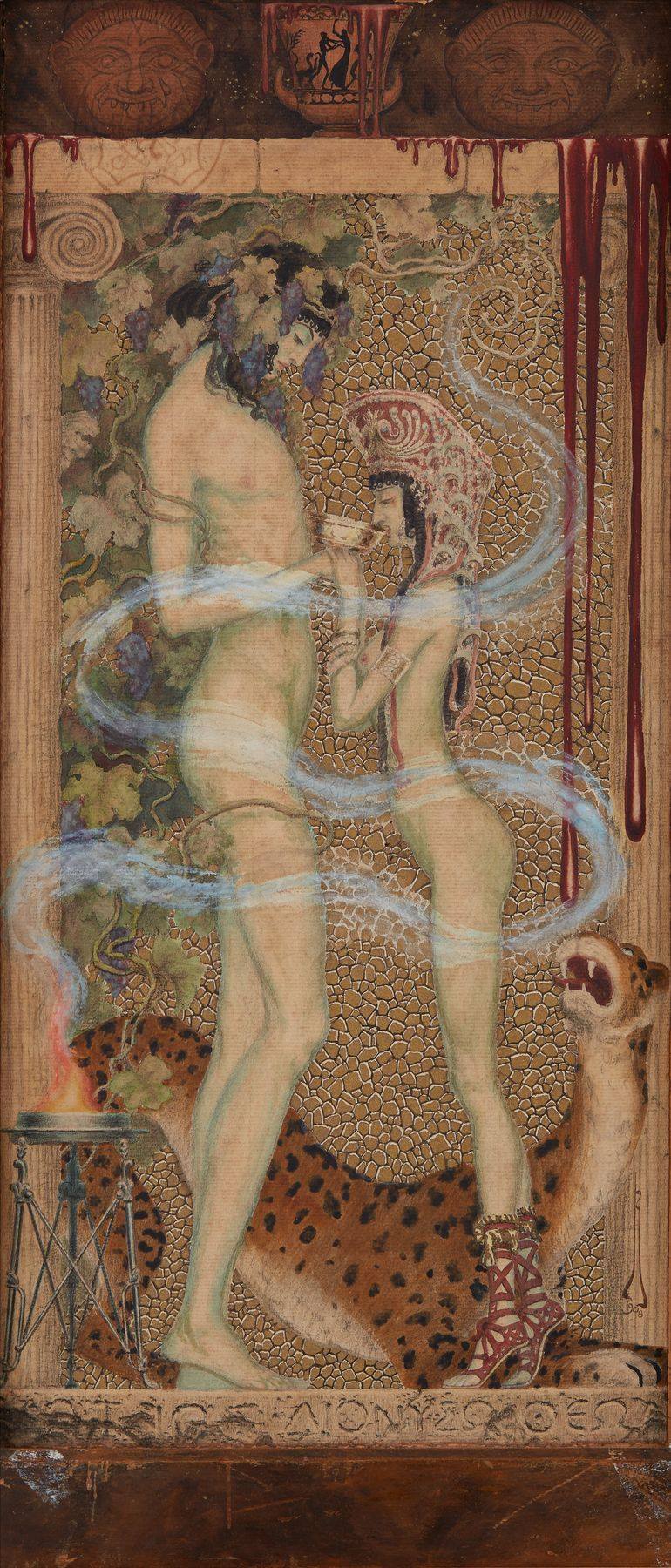
Dionysos
Nicholas Kalmakoff (Russian-French, 1873–1955)
A Brief History of the Dionysos Cult
The original Rite of Dionysos is almost universally held to have been a "wine cult", concerned with the cultivation of the grapevine, and a practical, understanding of its life cycle - embodying the living god - the creation and fermentation of wine - the dead god in the underworld - and the intoxicating and disinhibiting effects of the drink itself, believed to be a possession by the god’s spirit. In the first instance the cult was not only concerned with the lore of the vine alone, but equally with all the other components of wine. It should not be forgotten that wine once more commonly included many other ingredients, herbal, floral and resinous, adding to the quality, flavour and medicinal properties of the drink. The cultivation of all these also originally came under the lore of Dionysos, making it a general vegetation cult and herbal school. Honey and bees wax were also often added to early wine, bringing with them the associations of the even older mead lore and Neolythic bee cults (whose swarms were often associated with Dionysos as pure "life-force"). Later beer, plus grain/corn, cults were also incorporated into the domain of Dionysos, particularly via his partial assimilation of the Thracian deity Sabazius. Other plants believed to be viniculturally significant were also included in the cults retinue. Thus were added ivy, once thought to negate the effects of drunkenness, and to be the opposite of the grapevine, blooming in winter rather than summer, the vine of death as opposed to the vine of life; the fig, thought to be a purgative of toxins, and the pine, a wine preservative, taken from the evergreen. Similarly the bull, from whose hollowed horns wine was once drunk, and the goat, who provided wineskins and was the natural pruner of the vine, were also included as cult animals and manifestations of Dionysos. The predators or enemies of these were equally sacred, idealised as the panther and the poisonous snake (but see also Sabazius for serpents). Naturally the mythos already associated with these elements would also accrue to Dionysos, if not already there from the start. An understanding of both the practical realities of these processes, and their wider metaphorical significance, is crucial to any attempted understanding of the later primarily symbolic Mysteries of Dionysos, with their atavistic, life-death cycles.
The place of origin of the Hellenic Dionysian Mysteries is unknown, but they almost certainly first came to Greece with the importation of wine, which is widely believed to have originated, in the West, around 6000 BC in one of two places, either in the Zagros Mountains (the borderlands of Mesopotamia and Persia, both with their own rich wine culture since then) or from the ancient wild vines on the mountain slopes of Libya / North Africa (the source of early Egyptian wine from around 2500 BC, and home of many ecstatic rites), quite probably from both. Whatever the case it appears Minoan Crete was the next link in the chain, taking wine from both the Egyptians and Phoenicians and passing it on to the Greeks by 1600 BC, who would spread it throughout their colonies. Wine probably also entered Greece over land from Asia Minor. But it was most likely in Minoan Crete that the eclectic ‘wine cult’, that would become the Dionysian Mysteries, first emerged. Gradually evolving over the centuries, absorbing more mythic material wherever it was adopted. The Dionysos Mysteries would remain powerfully syncretic, absorbing the suppressed primeval cults of all the lands they touched. It would be the Greeks who were left with the task of making sense of the eclectic mix that reached them, and of integrating it into their own mythos with their inventive tales of the journeys and adventures of Dionysos.
The basic principle beneath the original initiations, other than the seasonal death-rebirth theme supposedly common to all vegetation cults (such as the Osirian, which closely parallels the Dionysian), was one of spirit possession and atavism. This in turn was closely associated with the effects of the wine. The spirit possession involved the invocation of spirits by means of the bull roarer, followed by communal dancing to drum and pipe, with characteristic movements (such as the backward head flick) found in all trance inducing cults (represented most famously today by African Voodoo and its relatives). As in Vodoun rites, certain drum rhythms were associated with the trance state, and these rhythms are allegedly found preserved in Greek prose, particularly the Bacchae of Euripides. One classical source describes what had become of these ancient rites in the Greek countryside, where they were held high in the mountains to which ritual processions were made on certain feast days:
"Following the torches as they dipped and swayed in the darkness, they climbed mountain paths with head thrown back and eyes glazed, dancing to the beat of the drum which stirred their blood…. In the state of ekstasis or enqousiasmos, they abandoned themselves, dancing wildly…. and calling 'Euoi!' At that moment of intense rapture they became identified with the god himself…. They became filled with his spirit and acquired divine powers". Peter Hoyle, Delphi (London: 1967), p. 76.
Unlike many trance cults however, the Dionysian rites were primarily atavistic, that is the participant was possessed by animal spirits and bestial entities, rather than intelligible divinities, and may even "transform into animals". A practise preserved by the rite of the "goat and panther men" of the "heretical" Aissaoua Sufi cult of North Africa, and remembered in the satyrs and sileni of the Dionysian procession, and perhaps even the "bull man", or Minotaur, of the chthonic Minoan labyrinth. But the most desired possession was that by Dionysos himself, or his consort Ariadne, though given the primal nature of these deities this is hardly discernable beyond the degree of power manifest. This practise is represented in Greek culture by the famous Bacchanals of the Maenads, Thyiades and Bacchoi. Dionysos in this bestial manifestation is believed to preserve the archaic archetype of the "Lord of the Animals" or the "Horned Hunter", and to a certain extent also the ambiguous "Trickster" archetype. In fact his ‘religion’ tended to absorb the remnants of these archetypes from the local culture wherever it was adopted (usually into Dionysos himself, or else, if still strongly established, as a mythic accomplice, such as his favoured companion the Arcadian Pan, or the ancient Silenus). Likewise the primeval and chthonic goddesses would become associated with Ariadne, or his mother Persephone / Semele. This ritualised atavism was also associated with a ‘descent into the underworld’ of which Dionysos was lord (‘Hades and Dionysos are one and the same’, declared Heraclitus).
The purpose of this atavism is controversial, some see it simply as a Greek saturnalian catharsis, a ritualised release of repressed elements of civilised psychology, and temporary inversion, in order to preserve it, others see it as a return to the "chaotic" sources of being and essentially a reaction against civilisation, while yet others regard it as a magical connection with chthonic powers. It is likely all of these applied in different manifestations of the cult. Like wine, Dionysos had a different flavour in different regions, reflecting their mythical and cultural soil, or "Terroir", and appeared under different names in neighbouring countries (or so claimed the Greeks).
The fact that these effects were attributed in part to Greek wines, that were barely 15% proof, has led many, including Robert Graves, to conclude some of its additives were of an hallucinogenic nature. This is certainly supported by suggestions of a "magic potion" associated with the Dionysos rites, said to include poison ivy, and by the known use of datura, henbane and belladona by shamans in this region, as well as the alleged use of "kykeon" (probably ergot ale), and possibly fly agaric mushrooms, within the Greek Eleusinian Mysteries. Dionysos was most probably regarded as the patron of all consciousness altering substances in Roman times, and potion making paraphenalia have been found in the ruins of Bacchic temples (with the potions, and "poisons", of the Bacchants also featuring in Roman smear campaigns against them). The sacraments used probably varied with the intentions of the Mysteries at any one time, but remained central to all but the most domesticated of the Bacchic sects, as did the associated shamanic idea of stepping outside of an ordered world into something more fundamental.
This primitive Dionysianism survived well into late classical times times on remote Greek islands, and in the wilds of Thrace and Macedonia, but elsewhere was soon adapted to a more "civilised" culture. A spectrum of such sects was to be found across the Greek world, but the height of domesticated kind was to be found at Athens, where atavistic possession became dramatic masked ritual within the Bacchic Thiasos (Greek coven or lodge), seeding the emergence of acting and theatre in the West (crafts also sacred to Dionysos, particularly at the great tragedy and comedy competitions in ancient Athens. From Tragedos, 'Goat Song', Death? And from Komos, 'Revelry'). The ethos of the rites also seems to have become slightly less atavistic and more liberative and sensual in Classical Greece, and a place where the repressions and inequalities of civilised culture could be evaded, albeit temporarily. Thus many of its initiates tended to be women or slaves, the most repressed classes in Greek society, from whom its "leadership" was often drawn, in a typical inversion of normal society. This inversion in fact became a theme of the Dionysian Mysteries, and the Thiasos a place where even kings and rulers could throw off the pressures of rule and convention, and live in carefree, natural equality with commoners for a while. Thus the Mysteries of Dionysos would be adopted by figures as diverse as Alexander the Great, popular monarchs such as Mark Anthony, and rebellious slaves such as Spartacus, all of whom were initiated, and all of whom considered themselves embodiments of Dionysos, interpreting his "liberation" in different ways. But perhaps the most famous of all initiates were the anonymous Maenads, or "wild women", who led the orgiastic rites of Dionysos and became possessed by his frenzy, or the more sensual Thyiades, who raved in the hills. While relatively tamed on the mainland by late Classical times, there still seem to have been outbreaks (or rumours of outbreaks) of primal Dionysianism in Greece, often associated with "foreign influences", the cult itself being seen as originating outside Greek civilisation. These outbreaks were both feared as potentially socially disruptive and envied with great fascination, one such incident inspiring the Euripides' play, the Bacchae.
The Hellenic world, after Alexander’s conquest, spread the cult of Dionysos internationally, to Egyptian Alexandria, where he was associated with Osiris (eventually merging with him as Serapis); to Palestine, where he was associated with the Baals, and even the Adonai of the Jews (who had Dionysos imposed on them by the Hellenes); and most far flung of all, to India, where he became associated with Shiva. These various connections all fed back to the Aegean, where the cult became increasingly complex and cosmopolitan. This would also led to a breakaway mystical form of Dionysianism that would become part of the more philosophical Orphic and Pythagorean Mysteries (where Dionysos was effectively seen as the creative Primal Chaos before creation, beyond all manifest duality, as well as the paradoxical, dynamic balancing force still active within it, the ‘King of the World’, whose final liberation included not only that from orderly civilisation but from the natural world itself!), a move in sharp contrast with the earthy and irrational primitive rite of Dionysos, that in some places still existed alongside it (reflecting a similar pattern to the evolution of Shivaic cults). A complex evolution still not fully understood.
The evolution of the Dionysian Cult continued in the Roman Empire, where the Bacchic Mysteries, as they were known here after their arrival in 200 BC, were banned for a time in Rome and forced underground, following rumours of their "corrupt" and "subversive" behaviour (In 186 B.C. the Roman senate had sought to ban the Dionysian rites throughout the Empire, and restricted their gatherings to no more than 13 people, but was never fully successful. They were revived under Julius Caesar around 50 BC, and remained in existence, along with the Bacchanalian street procession, at least until the time of Augustine (A.D. 354-430)) Those Bacchic cults that survived into late Roman times are often considered degenerate forms, tending to be either rites of empty public theatre, or private excuses for orgies and drunkenness, but it now appears a few low profile Thiasoi did remain, particularly in Southern Italy. It is not surprising that early Christians should thus equate Bacchus and his company with the Devil (despite adopting quite a few of his cult trappings themselves, most obviously the wine communion). The purest survival of the Bacchic cult is perhaps the Lent Carnival which survives in Latin countries even today.
Today people often claim the precursors of Christianity, Devil Worship and Witch Covens in the Rites of Dionysos, with probably both a little justification and much imagination.
61 notes
·
View notes
Text



Maki Yamamoto’s appreciation for Palestinian tatreez goes back far before she began seamlessly weaving the indigenous cross-stitch embroidery into Japan’s most well-known form of traditional clothing, the kimono.
“For me and those who know the history of kimonos, it's a very natural pairing because the kimono has been influenced by neighbouring countries by the way of the Silk Road – China, Korea, Persia, Syria and many other cultures,” Yamamoto shares.
From the TRT World article Palestinian tatreez in Japanese kimonos: A cultural symbol of solidarity
89 notes
·
View notes
Text
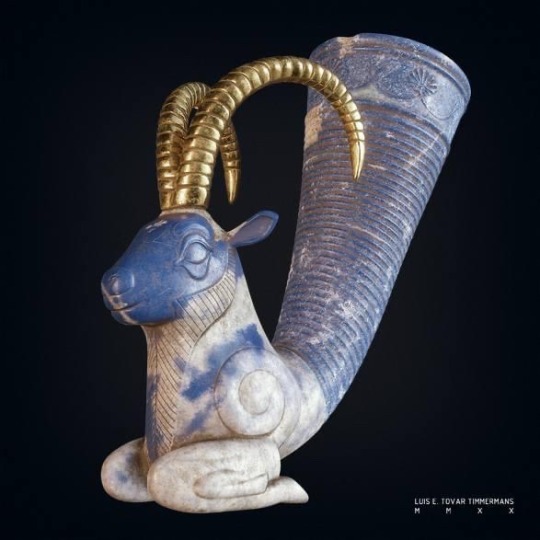
In the heart of the ancient Achaemenid Empire, a masterpiece of Persian artistry emerges—a rhyton (drinking horn or in the shape of a horn) carved from the deep blue lapis lazuli and adorned with gold, taking the form of a majestic ibex (mountain goat).
Dating back to the 6th to 5th century BCE, this exquisite ceremonial vessel not only exemplifies the sophisticated craftsmanship and rich symbolism of the time but also provides a fascinating glimpse into the cultural and economic prowess of ancient Persia.
[Description and Material]:
*Material:
Lapis lazuli, a semi-precious stone prized for its deep blue color, was highly valued in ancient Persia and sourced primarily from what is now Afghanistan.
*Form:
The rhyton is shaped like an ibex, a type of wild goat with prominent, curved horns, reflecting the importance of nature and animal motifs in Persian art.
[Use]:
*Function:
A rhyton is a type of vessel typically used for drinking or pouring liquids, especially in ceremonial contexts. The liquid would be poured from the top and flow out through the spout, which could be the mouth of the animal in this case.
*Ceremonial Role:
Rhytons were often used in religious and royal ceremonies. The choice of lapis lazuli and the intricate craftsmanship suggest that this particular rhyton was likely used by the elite, possibly in rituals associated with the Zoroastrian religion or royal banquets.
[Cultural and Historical Significance]:
*Art and Symbolism: The ibex design reflects the importance of wildlife in Persian culture and the symbolic use of animals in conveying power and divinity. The ibex, with its strong and agile form, could symbolize qualities such as strength and resilience.
*Trade and Wealth: The use of lapis lazuli indicates extensive trade networks and the wealth of the Achaemenid Empire, as this material was not locally sourced and had to be imported.
*Royal Patronage: The Achaemenid rulers were great patrons of the arts, and such luxurious items underscore their desire to display their wealth, power, and cultural sophistication.
[Academic Perspective on Material Culture]:
*Cultural Synthesis:
Scholars often view Achaemenid art, including rhytons, as a synthesis of various cultural influences, including Mesopotamian, Egyptian, and Greek, reflecting the diverse and cosmopolitan nature of the empire.
*Representation of Power:
Academics see these artifacts as representations of royal propaganda, showcasing the divine right and grandeur of the Persian kings.
*Symbol of Status:
In material culture studies, such high-quality items are considered symbols of social status and wealth. They provide insights into the social hierarchy and economic conditions of the time.
*Artistic Techniques:
The craftsmanship of the rhyton is analyzed for its artistic techniques, such as carving and polishing lapis lazuli, which indicate advanced skills and aesthetic values.
[Notable Examples]:
Museums and Collections: Notable examples of such rhytons can be found in major museum collections, such as the British Museum and the Louvre, where they are studied and displayed as prime examples of Achaemenid artistry and craftsmanship.
In conclusion, the lapis lazuli rhyton in the shape of an ibex from the Achaemenid period is a significant artifact that illustrates the artistic, cultural, and economic aspects of ancient Persia. It serves as a key piece of material culture, providing valuable insights into the ceremonial practices, trade networks, and socio-political dynamics of the Achaemenid Empire.
#ancient Persia#Zoroastrianism#ceremonial vessel#rhyton#lapis lazuli#Iran#Mesopotamia#Ancient history#Near East#ancient civilisations#ancient art#ancient craft#archaeology#Achaemenid#Achaemenid Culture
47 notes
·
View notes
Text
🌿 Herb Of The Day

Title: Lilac
Gender: Feminine
Element: Water
Planet: Venus
📜 Folklore & History 📜
Lilacs are an old, old, species that originated in Persia and then traveled to Europe. They were brought to America in 1750 and then planted at New Jersey Governor Wentworth’s home. Other prominent men fell in love with lilacs. They were reportedly one of Thomas Jefferson’s favorite flowers, and he documented his lilac-planting-methods in 1767. George Washington followed suit and moved existing lilacs on his property to his garden in 1785.
In Greek mythology, Pan, the god of the wild, chased a nymph named Syringa. She turned herself into a lilac bush to escape Pan, and in anger, he broke off the reed-like branches which made pipes. With regret, he tried kissing the broken branches, and as his air pushed over them, sounds were made. Lilacs were responsible for the creation of “Panpipes.”
Russian folklore believed that hanging lilacs above a baby’s bed would bring the child wisdom.
American folklore thought that lilacs could drive away evil and that placing them in a haunted house would displace ghosts. Thought to be symbolic of “old love,” Victorian widows often wore lilacs as a sign of remembrance. One hundred and fifty-five years ago today, April 15th, Abraham Lincoln died after being shot by John Wilkes Booth. Any American — and much of the world — knows the story of the self-educated, country lawyer who became one of our nation’s most beloved presidents. But what many Americans might not realize is how the death of Lincoln reverberated into so many areas of our collective psyche, including literature and horticulture, thanks to Walt Whitman. Walt Whitman was a reporter, printer, writer, traveler and Civil War nurse who is considered one of America’s greatest poets. He self-published Leaves of Grass and worked on it throughout his lifetime, eventually modifying it so that there are eight different editions. Whitman felt a great affinity with President Abraham Lincoln, and when Lincoln was assassinated in the spring of 1865, Whitman grieved.
He wrote years later in Specimen Days about learning of the President’s death:
"I remember where I was stopping at the time, the season being advanced, there were many lilacs in full bloom. By one of those caprices that enter and give tinge to events without being at all a part of them, I find myself always reminded of great tragedy of that day by the sight and odor of these blossoms. It never fails."
While lilacs are first to bloom, their flowers are short-lived. The heady fragrance lingers sweetly at first, but then the blooms start to die, leaving a heavy, cloying smell. One of the first flowers of spring, lilacs contain a natural compound called indole that’s found in flowers — and feces. It’s that undercurrent of the “bottom note” of fragrance that suggests decay and death.

🔮 Metaphysical Properties 🔮
The beautiful May-blooming lilac is one of the loveliest tokens of spring. But they are much more than beautiful shrubs with showy, sweet-smelling flowers. Originally lilacs were planted to repel all evil. Planted near the entryway, lilacs were believed to send out protective vibrations. When the flowers are cut and brought into the home they cleanse any living space. And they'll also remove any unwanted spiritual presence. Blue and white varieties work well for this purpose. Since lilacs are ruled by Venus, they are also used in love spells. Try placing some pink lilacs on your altar while performing a love spell. The dried flowers make a powerful addition to any love sachet.

🍴⚕️ Culinary & Medicinal Properties
The simplest way to enjoy lilacs is as an infusion of the flowers for a lilac sugar. The sugar can then be used in recipes to add lilac flavor to baked goods. This also works with a lilac simple syrup which is just a liquid form of the same thing that’s perfect for making cocktails. For my money though, I think lilac infused honey sounds the best. The sweet floral flavor of lilacs translates beautifully into an ice cream base.
To prevent the recurrence of disease, lilac flowers were used to help strengthen the system and prevent relapse after a patient had healed. They’re said to be specifically good after cases of malaria. Tasting the raw flowers you can actually pick up some of the astringent qualities, as they make your mouth dry and pucker a bit (along with their floral flavors). This astringent quality makes them good for use in skin care products. Lilacs are used as a folk remedy for intestinal worms, as well as a treatment for gastric discomfort and gas. Regardless of the purpose, the most likely medicinal lilac preparation is a tincture, which is just a lilac infused alcohol
#elder witch#baby witch#beginner witch#dark witchcraft#herbalism#herbology#herbs#whimsigoth#witch aesthetic#witch herbs#divination#spirituality#spiritual#witchblr#witchcore#witchcraft#witch tip
473 notes
·
View notes
Text

"From Egypt, the Mysteries went to Phoenicia, and were celebrated at Tyre. Osiris changed his name, and become Adonis or Dionysos, still the representative of the Sun; and afterward these Mysteries were introduced successively into Assyria, Babylon (it goes back to Enki/Ea), Persia, Greece, Sicily, and Italy; even in the British Isles the Druids celebrated those of Dionysos, learned by them from the Egyptians. In Greece and Sicily, Osiris took the name of Bacchus, and Isis (probably Ninti) that of Ceres, Cybele, Rhea and Venus." Albert Pike
"The fish is one of the most ancient symbols, and it was the original symbol of Christianity. Jesus, as the fisher of men, or the fish man, appears to come from the Chaldean story of Dagon, who came out of the sea and brought religion, philosophy, and science to his people. Fishes were also sacred to the Greeks and Romans, being connected with the worship of Aphrodite (Venus). An interesting survival of pagan ritualism is found in the custom of eating fish on Friday. Freya, in whose honor the day was named, was the Scandinavian Venus. Green is the color of the Prophet Mohammed and, being symbolic of verdure, is inevitably associated with the World Mother; and both the Islamic crescent and the scimitar may be interpreted to signify the crescent shape of either the moon or Venus (Jumu'ah - Freya/Friday prayer). Moreover, the checkerboard floor upon which the modern Freemasonic lodge stands is the old tracing board of the Dionysiac Architects." Manly P. Hall
25 notes
·
View notes
Text

Pearls are the oldest 'gem' known to mankind. Chinese, Indians, Persians, and Egyptians already had their type of obsession with it, later the Romans and Byzantines followed this "pearl-holic" fashion.
In the 17th century, the great potences of the world were no different. After the Spanish and Portuguese took to the sea, they brought with them the pearls of Persia, India, and the Americas, which made the tastes of the great European monarchies. The Spanish crown, together with the English monarchs, had a hunger for such treasure.
It became part of the fashion of the Tudor, the Mughal, the Habsburg, and the Qajar.
Nobles, bourgeoises, and Merchants alike started wearing them as a sign of high rank and monetary power. Pearls were a symbol of sensuality and seduction, even being used to send signals to possible partners.
Japanese in the Edo Period weren't big on jewelry, except hairpins. Showing their wealth in other ways like gold thread, silk and lacquered shoes...speaking of shoes:

Not my art btw. The shoes that Heiji is wearing.
The Heitan they're using is of silk and fur, not something seen all too much but worn by some wealthy eccentric merchants. - Maybe even shogun-
I'll never not draw Abijah wearing his typical linen poet shirts. Being the rich seaman he is he'd have dozens or more of flamboyant frilly linen shirts, or maybe, being as gold filled as he is, maybe even Muslin tunics. And yes he's too vain to not show his hairy big chest.
My idea is that Abijah made huge health on the Orient seas before going to Japan, having chests and closets filled with rich cloths, clothes, jewelry, oils, perfumes, and many other treasures. And what he doesn't have he gets by trading (maybe some north Chinese routes that connected to Hokkaido and Aomori). He loves excess and shares such love with Heiji. Maybe spoiling him a bit...
Chocolate maybe? But that's for another drawing.
My favorite detail are their douchebag faces.
23 notes
·
View notes
Note
Was Alexander in love with Roxane? As far as I understand, Plutarch, Diodorus, Justin and Arrian mention that Alexander was in love with Roxane, she is the only wife he is said to have been in love with. Is there any truth to that? I have seen people question it, but they are the same people who say that Alexander loved Hephaestion (romantically) when no such thing is said in any source.
So, here’s another “ask” that I’m not sure isn’t meant as trolling. That said, as before, I’ll give it the benefit of the doubt. The first part at least seems genuine enough. It’s only the second part that strikes as a bit dismissive.
That said, the question suggests both limited knowledge of who is arguing what (see the suggested reading near the end), as well as a disconnect between pop history online versus actual scholarship.
For historians, this is not about “We want to make Alexander gay!” versus “We want to make Alexander straight!” This is about understanding the HISTORIOGRAPHY of the ancient sources: what to believe and what not to believe, which in turn means understanding the agenda of ancient authors. That makes this question fundamentally problematic for two reasons:
It assumes one of these things cancels out the other. It doesn’t.
It assumes the ancient sources can be trusted, and all of them say the same things about Roxane, with the same motives. They don’t.
A colleague of mine is currently working on a paper about the role of “love” in stories of Macedonian kings (not just Alexander) and specific wives (who bear the heir). I’m not going to say more about that, as I don’t want to steal Borja’s thunder, but he let me read a draft of the paper and I found it very interesting. Yet we shouldn’t take these “love stories” at face value.
The asker must remember that our surviving sources are separated from Alexander by at least 300 years, or more. They have other (now lost) sources between them and Alexander—sometimes more than one source. I’ve talked about the problems with the sources and Alexander in these two TikTok videos:
ATG and the Sources, Part 1
ATG and the Sources, Part 2
I’d suggest watching those first, then returning here to finish reading this post.
So, assuming the asker (and other readers) have now seen those two videos, we must consider the “story” that lies behind reports of Alexander marrying Roxane for love … or not.
Plutarch is one of the main surviving sources for the “He fell in love with her story,” as well as the “He never laid eyes on Statiera,” as well as the “He turned up his nose at prostitutes (both male AND female).” It’s not about the “purity” of a love match, but CONTROL of his sexual impulses. E.g., sophronsunē. Please don’t conflate Plutarch’s point with later Christian moral lessons. Plutarch was not a Christian and would have emphatically disagreed with many aspects of Christian theology.
Plutarch is telling a story in his Life of Alexander about how Alexander rose above his semi-barbaric Macedonian origins (of which Olympias and Philip are symbols) due to his GOOD GREEK PAIDEIA (education). He was properly “Greekified.” He was therefore controlled and reserved and properly virtuous when he invaded Persia. After Gaugamela, however, he began to succumb to the alure of Evil Oriental Debauchery. Sadly, the Roxane story is part of that—she’s a barbarian girl—although marrying her for love kinda redeems it. This view of Alexander is part of the Second Sophistic more broadly, so we also find it in Arrian. Curtius and Justin are both Roman imperial authors, but with a similar message. Not the Greek education part, but the “corrupted by the Oriental East” part. Diodoros (writing earliest of all) also has it, but not as emphatic.
Marrying Roxane, especially for Curtius, is not a good thing. She’s a hillbilly barbarian tart! He marries (gasp!) her because he gives in to his impulses instead of controlling them with Roman discipline. It’s almost the opposite of Plutarch. Marriage makes it worse, not better, opening the way for half-barbarian heirs (shudder).
What really spurred Alexander’s marriage to her was a political alliance with important Baktrian and Sogdian families, so he could get the hell out of there after a 2+ year war against regional insurgency (which he actually caused). You can read about the whole thing in Frank Holt’s brilliant Alexander the Great and Bactria, from Mnemosyne (1993). And last time I checked, Frank wasn’t making any arguments at all about Hephaistion.
Sulochana Asirvatham has written several articles about Plutarch and Alexander, but “Plutarch’s Alexander” might be of the most use from Brill’s Companion to the Reception of Alexander the Great. Sulo isn’t making any arguments about Hephaistion either. I don’t think he even comes up in that paper.
Sabine Müller has also written about Alexander and women, including Roxane (“Stories of the Persian Bride, Alexander and Roxane,” in The Greek Alexander Romance in Persia and the East). She, too, not only doesn’t argue that Hephaistion was his lover, but (elsewhere) argues they weren’t. We agree on a lot about Hephaistion’s career and importance, but not on that particular point.
Finally, you might especially want to read a forthcoming book chapter “Alexander’s Polygamy: Remarks on Alexander the Great’s Relationship(s) with Women,” by Monica D’Agostini in Macedon and Its Influences, coming out either late this year or early next, from Colloquia Antiqua (#44). It deals with Barsine, Roxane, and his other women/wives.
There is also here the matter of what love and marriage meant in ancient Greece and Macedonia, versus now, but that’s a whole ‘nother discussion. As noted above, for the Greeks, loving a woman did not in any way, shape, or form preclude loving a boy/man. Even at the same time!
Ergo, the idea that people who argue he didn’t love Roxane are doing so because they (wrongly) want to believe he was in love with Hephaistion is, frankly, ridiculous, not to mention downright offensive to real scholarship. As if our opinions are driven by romantic wishful thinking instead of a careful evaluation of the sources and their reliability, in terms of both what is said, and what isn’t.
(Apologies for being a tad testy if this was not a troll, but I've fielded a few too many of these sorts of queries that are a backhanded attempt to "prove" that any claim Hephaistion and Alexander were lovers is just romantic claptrap by silly women who aren't "real" scholars. Ergo, my skepticism.)
#asks#Roxane#Roxana#Alexander the Great#Hephaistion#Hephaestion#Alexander's relationships#possible baiting#historiography#classics#ancient macedonia#ancient Greece#source messaging about Alexander#sophrosune#Plutarch
18 notes
·
View notes
Text
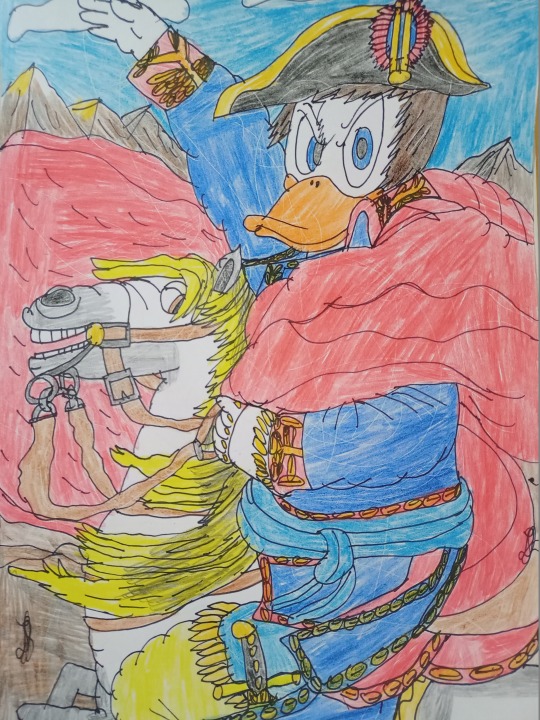
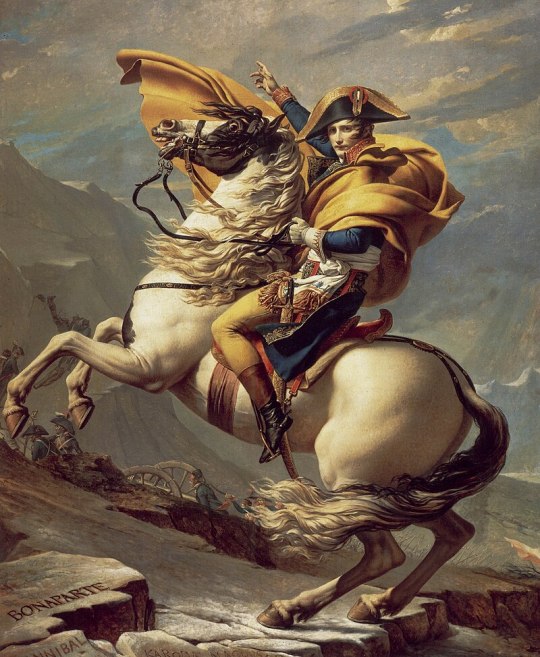
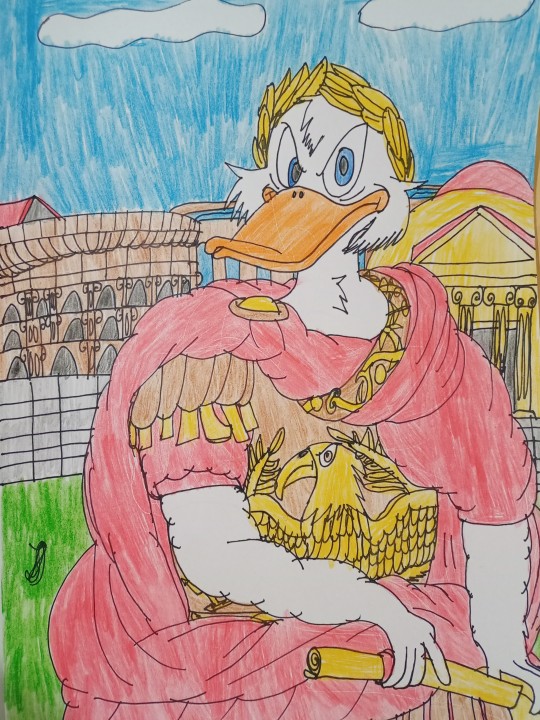
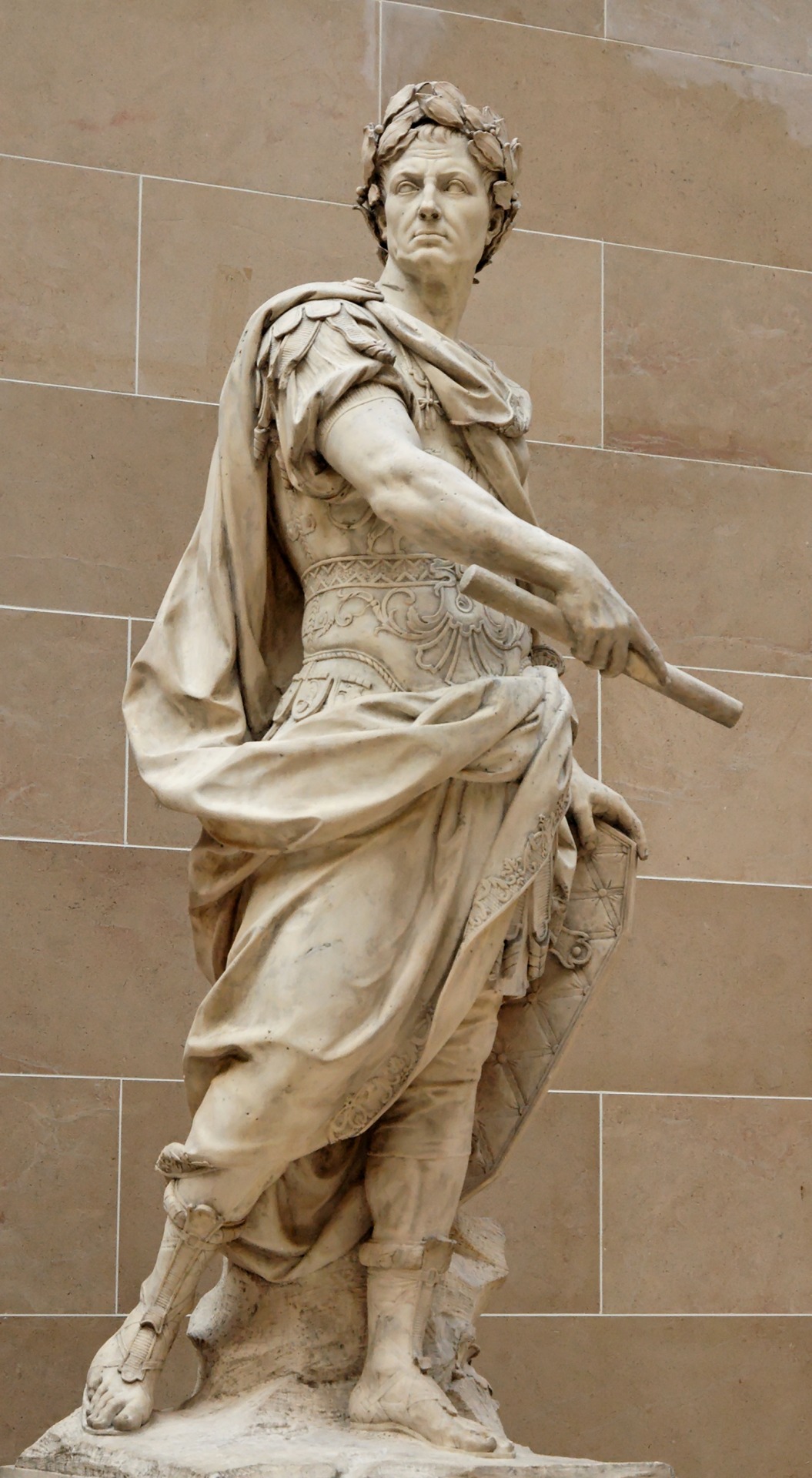
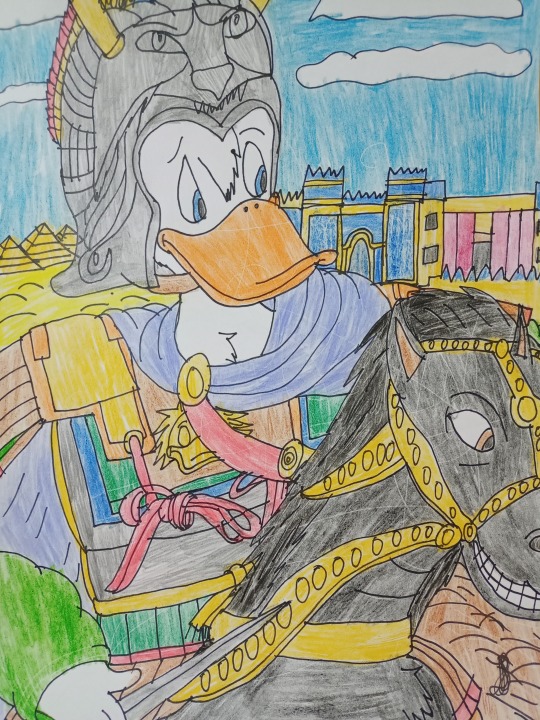
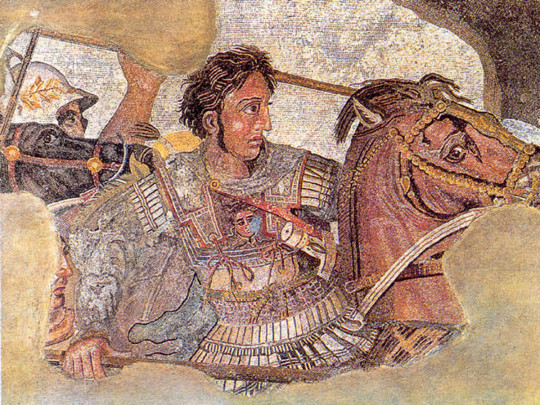
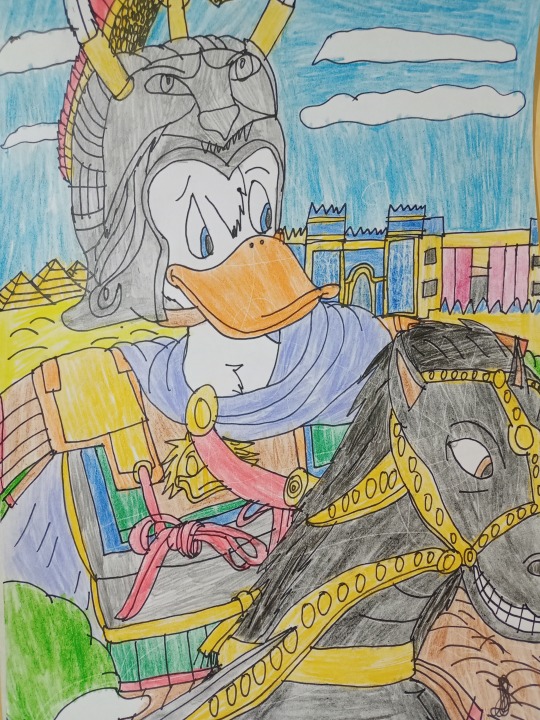
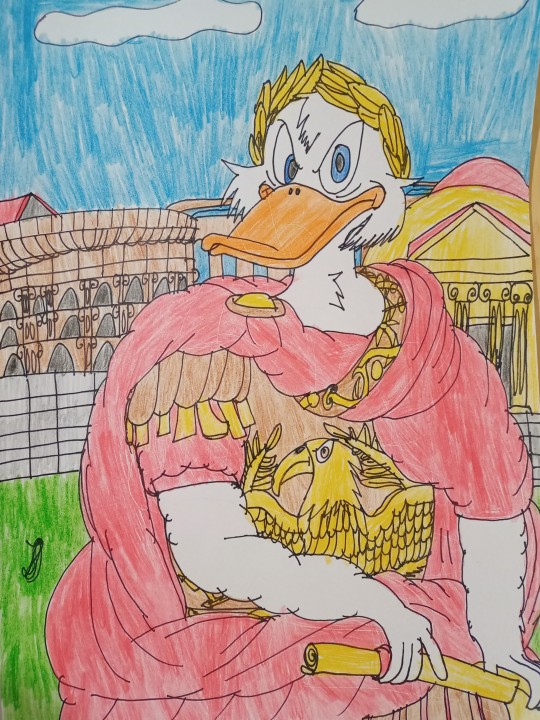
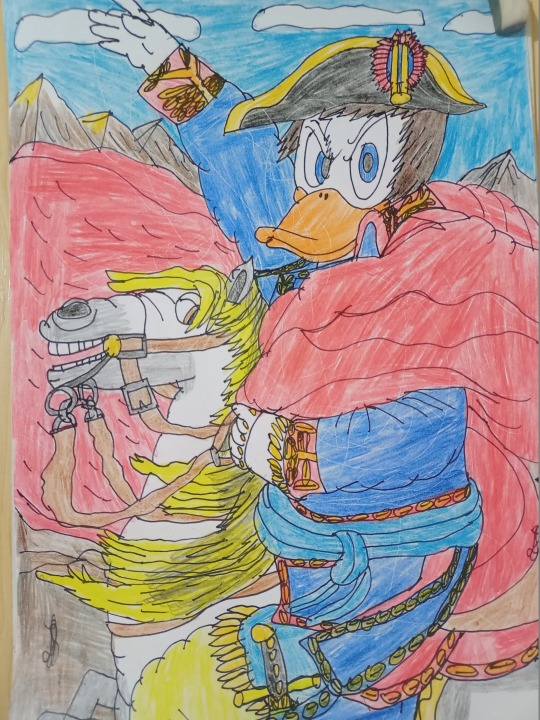
Donald Duck as Napoleon Bonaparte, Scrooge McDuck as Gaius Julius Caesar and Louie Duck (Quack Pack) as Alexander the Great - Conquerors - Real Ducks in History - History in Duckverse
I've always wanted to do a special project called Duckverse in History and my plan is to draw my favorite characters as redraws from famous works of art as well as famous historical figures. And since history is my favorite science, and my favorite field, I definitely wanted to do something related to it and related to one of my favorite historical characters. Since I don't want to complicate the situation, I will gradually publish a drawing related to that historical figure from time to time. I started this last year for Duckvember only to finish at the end of last month.
The first drawing is a redraw from Jacques Louis David's famous early 19th century artwork depicting Napoleon Bonaparte crossing the Alps in 1800 before the Battle of Marengo. Napoleon Bonaparte was the most famous French military leader, general, consul and emperor who waged war with all of Europe at the time and managed to subjugate it in its entirety except for the Ottoman Empire, Russia and Great Britain. He is from Corsica, but he left a lot for France and proved that France is not worth messing with easily. He also gave many reforms and his Civil Code which spread throughout Europe and brought order in France after the French Revolution. Napoleon's nature is very similar to Donald Duck and I drew Donald as Napoleon since he was created for that role and I drew him riding his horse Marengo in my own style, but in a realistic way and that Donald has five fingers.
The second drawing is a redraw of a statue made by Nicolas Coustou at the end of the 17th century for the decoration of Versailles, which depicts the greatest Roman, Gaius Julius Caesar. Although he was not an emperor, certainly many presented him, but he was a dictator, consul, general, writer, historian, engineer, constructor, and a great military leader who changed the Roman Republic into an almost Roman Empire. His fights against the Gauls, as well as the conflict with Pompey and his love with Cleopatra, are known, but he also changed a lot in Rome and was extremely rich. And he lived during the first century BC. That's why I drew Scrooge McDuck as Gaius Julius Caesar since Scrooge is a great leader and he also strived for fame and fortune and to be remembered in the future and he plays the role of the best Roman. Behind it are the Colosseum (built a century after him), the aqueduct (then irrigation) and the Pantheon (built two centuries after him), as well as a Roman temple that symbolizes Rome at that time, as well as the roads themselves. In addition, Topolino (Italian comics) are showed Scrooge as Caesar two or three times so that's where my inspiration came from.
The third drawing shows Louie Duck (the Quack Pack version, not the Ducktales reboot) shows Alexander the Great, another brilliant conqueror from the fourth century BC and I drew it as a redraw from the mosaic of Alexander the Great from the battle of Issus in which he confronts the Persian king Darius III from Pompeii, probably from the first century BC. Alexander the Great was the son of Philip II and the king of Macedonia who united Greece and fought against Persia and managed to conquer an entire empire in his twenties. He traveled through the Persian Empire and reached India and wanted to continue, but his soldiers did not want to continue, so he returned to Babylon, his new capital. He certainly changed the world at that time and introduced a new culture, called Hellenism, as a combination of ancient Greek culture and the culture of the Ancient East and ancient India. I drew Louie as Alexander because as a young man he is a great adventurer and rides his black horse Bucephalus and is eager for extremes, yet unlike Alexander, Louie shows a bit of his shyness, but is still brave enough to take on new challenges. I also added a helmet as worn by Alexander III in his time. Behind Louie are the pyramids from Egypt, the Ishtar Gate from Babylon and the imperial palace from Persepolis where the Persian rulers lived and it actually shows the lands that Alexander the Great conquered.
I certainly hope you like these drawings and these ideas and that these characters have such historical roles. Of course, Duckverse in history I combine mostly everything related to Duckverse (Donald Duck comics, OG Ducktales, Three Caballeros, Darkwing Duck and Quack Pack) and it's mostly my version and my idea. By all means if you like this and support these ideas, feel free to like and reblog this, but please don't use these same ideas without mentioning me and without my permission. Thank you!
#my fanarts#traditional art#artists on tumblr#donald duck#history#duckverse#ducktales#napoleon bonaparte#gaius julius caesar#alexander the great#scrooge mcduck#louie duck#quack pack#disney ducks#duckverse in history#disney duck comics#rome#france#topolino#greece#disney duckverse#quack pack au#art#my redraws#the conquerors#my fanart#comics#cartoons#my style#julius ceaser
34 notes
·
View notes
Text
The Synagogue of Singapore: A Historical Overview
As someone with a rich Jewish heritage, the history of the Maghain Aboth Synagogue in Singapore holds a special place in my heart. This synagogue represents not only the perseverance and unity of the Jewish community but also my personal connection to a legacy that has endured for generations. It's a beacon of faith, culture, and history that resonates deeply with my sense of identity and belonging.
The Maghain Aboth Synagogue, located in Singapore, is the oldest Jewish synagogue in Southeast Asia. Established in 1878 by the Jewish community, primarily comprised of Sephardic Jews from Baghdad, it has served as a central place of worship and community for over a century.
The Jewish presence in Singapore dates back to the early 19th century, with traders and merchants arriving from regions such as India, Iraq, and Persia. As the community grew, the need for a dedicated place of worship became evident. The Maghain Aboth Synagogue was constructed on Waterloo Street, designed in a neoclassical style that blends with Singapore's diverse architectural landscape.
Over the years, the synagogue has witnessed significant events, including World War II, when it served as a refuge and community center during the Japanese occupation. Despite the challenges, it remained a steadfast symbol of the Jewish faith and resilience in Singapore.
In the 20th century, the synagogue underwent renovations to preserve its structure and accommodate the growing community. It continues to serve as the focal point for Jewish religious life in Singapore, hosting services, festivals, and cultural events.
Today, the Maghain Aboth Synagogue stands as a testament to the enduring legacy and contributions of the Jewish community in Singapore. It not only represents a place of worship but also a historical landmark reflecting the multicultural tapestry of the city-state.
Axel Laniez

#synagogue#singaporesynagogue#jewish#jewish history#judaism#beauty#tolerance#heritage#singapore#southeast asia#travel#asia#Southeast Asia#sea
26 notes
·
View notes
Text
Countries that are no more: Achaemenid Empire (550BC-330BC)
It was not the first empire of Iranian peoples, but it arose as probably the greatest in terms of influence and became the measure by which all subsequent Iranian empires tended to compare themselves and its influence on culture, government & civil infrastructure would influence others beyond the span of its territory and the span of time. This is the Achaemenid Empire.
Name: In Old Persian it was known as Xšāça or the "The Kingdom or the Empire", it was named the Achaemenid Empire by later historians. Named after the ruling dynasty established by its founder Cyrus the Great who cited the name of his ancestor Haxāmaniš or Achaemenes in Greek as progenitor of the dynasty. It is sometimes also referred to as the First Persian Empire. The Greeks simply referred to it as Persia, the name which stuck for the geographic area of the Iranian plateau well into the modern era.
Language: Old Persian & Aramaic were the official languages. With Old Persian being an Iranian language that was the dynastic language of the Achaemenid ruling dynasty and the language of the Persians, an Iranian people who settled in what is now the southwestern Iranian plateau or southwest Iran circa 1,000 BC. Aramaic was a Semitic language that was the common and administrative language of the prior Neo-Assyrian & Neo-Babylonian Empires which centered in Mesopotamia or modern Iraq, Syria & Anatolian Turkey. After the Persian conquest of Babylon, the use of Aramaic remained the common tongue within the Mesopotamian regions of the empire, eventually becoming a lingua franca across the land. As the empire spread over a vast area and became increasingly multiethnic & multicultural, it absorbed many other languages among its subject peoples. These included the Semitic languages Akkadian, Phoenician & Hebrew. The Iranian language of Median among other regional Iranian languages (Sogdian, Bactrian etc). Various Anatolian languages, Elamite, Thracian & Greek among others.
Territory: 5.5 million kilometers squared or 2.1 million square miles at its peak circa 500BC. The Achaemenid Empire spanned from southern Europe in the Balkans (Greece, Bulgaria, European Turkey) & northwest Africa (Egypt, Libya & Sudan) in the west to its eastern stretches in the Indus Valley (Pakistan) to parts of Central Asia in the northeast. It was centered firstly in the Iranian Plateau (Iran) but also held capitals in Mesopotamia (Iraq). Territory was also found in parts of the Arabian Peninsula & the Caucausus Mountains.
Symbols & Mottos: The Shahbaz or Derafsh Shahbaz was used as the standard of Cyrus the Great, founder of the empire. It depicts a bird of prey, typically believed to be a falcon or hawk (occasionally an eagle) sometimes rendered gold against a red backdrop and depicts the bird holding two orbs in its talons and adorned with an orb likewise above its head. The symbolism was meant to depict the bird guiding the Iranian peoples to conquest and to showcase aggression & strength coupled with dignity. The imperial family often kept falcons for the pastime of falconry.
Religion: The ancient Iranian religion of Zoroastrianism served as the official religion of the empire. It was adopted among the Persian elite & and had its unique beliefs but also helped introduce the concept of free-will among its believers, an idea to influence Judaism, Christianity & Islam in later centuries. Despite this official religion, there was a tolerance for local practices within the subject regions of the empire. The ancient Mesopotamian religion in Babylon & Assyria, Judaism, the Ancient Greek & Egyptian religions & Vedic Hinduism in India was likewise tolerated as well. The tolerance of the Achaemenids was considered a relative hallmark of their dynasty from the start. Famously, in the Old Testament of the Bible it was said that it was Cyrus the Great who freed the Jews from their Babylonian captivity and allowed them to return to their homeland of Judea in modern Israel.
Currency: Gold & silver or bimetallic use of coins became standard within the empire. The gold coins were later referred to as daric and silver as siglos. The main monetary production changes came during the rule of Darius I (522BC-486BC). Originally, they had followed the Lydian practice out of Anatolia of producing coins with gold, but the practice was simplified & refined under the Achaemenids.
Population: The estimates vary ranging from a low end of 17 million to 35 million people on the upper end circa 500BC. The official numbers are hard to determine with certainty but are generally accepted in the tens of millions with the aforementioned 17-35 million being the most reasonable range based on available sources.
Government: The government of the Achaemenid Empire was a hereditary monarchy ruled by a king or shah or later referred to as the ShahanShah or King of Kings, this is roughly equivalent to later use of the term Emperor. Achaemenid rulers due the unprecedented size of their empire held a host of titles which varied overtime but included: King of Kings, Great King, King of Persia, King of Babylon, Pharaoh of Egypt, King of the World, King of the Universe or King of Countries. Cyrus the Great founded the dynasty with his conquest first of the Median Empire and subsequently the Neo-Babylonians and Lydians. He established four different capitals from which to rule: Pasargadae as his first in Persia (southwest central Iran), Ecbatana taken from the Medians in western Iran's Zagros Mountains. The other two capitals being Susa in southwest Iran near and Babylon in modern Iraq which was taken from the Neo-Babylonians. Later Persepolis was made a ceremonial capital too. The ShahanShah or King of Kings was also coupled with the concept of divine rule or the divinity of kings, a concept that was to prove influential in other territories for centuries to come.
While ultimate authority resided with the King of Kings and their bureaucracy could be at times fairly centralized. There was an expansive regional bureaucracy that had a degree of autonomy under the satrapy system. The satraps were the regional governors in service to the King of Kings. The Median Empire had satraps before the Persians but used local kings they conquered as client kings. The Persians did not allow this because of the divine reverence for their ShahanShah. Cyrus the Great established governors as non-royal viceroys on his behalf, though in practice they could rule like kings in all but name for their respective regions. Their administration was over their respective region which varied overtime from 26 to 36 under Darius I. Satraps collected taxes, acted as head over local leaders and bureaucracy, served as supreme judge in their region to settle disputes and criminal cases. They also had to protect the road & postal system established by the King of Kings from bandits and rebels. A council of Persians were sent to assist the satrap with administration, but locals (non-Persian) could likewise be admitted these councils. To ensure loyalty to the ShahanShah, royal secretaries & emissaries were sent as well to support & report back the condition of each satrapy. The so called "eye of the king" made annual inspections of the satrapy to ensure its good condition met the King of Kings' expectations.
Generals in chief were originally made separate to the satrap to divide the civil and military spheres of government & were responsible for military recruitment but in time if central authority from the ShahanShah waned, these could be fused into one with the satrap and general in chiefs becoming hereditary positions.
To convey messages across the widespread road system built within the empire, including the impressive 2,700 km Royal Road which spanned from Susa in Iran to Sardis in Western Anatolia, the angarium (Greek word) were an institution of royal messengers mounted on horseback to ride to the reaches of the empire conveying postage. They were exclusively loyal to the King of Kings. It is said a message could be reached to anywhere within the empire within 15 days to the empire's vast system of relay stations, passing message from rider to rider along its main roads.
Military: The military of the Achaemenids consisted of mostly land based forces: infantry & cavalry but did also eventually include a navy.
Its most famous unit was the 10,000-man strong Immortals. The Immortals were used as elite heavy infantry were ornately dressed. They were said to be constantly as 10,000 men because for any man killed, he was immediately replaced. Armed with shields, scale armor and with a variety of weapons from short spears to swords, daggers, slings, bows & arrows.
The sparabara were the first line of infantry armed with shields and spears. These served as the backbone of the army. Forming shield walls to defend the Persian archers. They were said to ably handle most opponents and could stop enemy arrows though their shields were vulnerable to enemy spears.
There was also the takabara light infantry and though is little known of them it seems they served as garrison troops and skirmishers akin to the Greek peltast of the age.
The cavalry consisted of four distinct groups: chariot driven archers used to shoot down and break up enemy formations, ideally on flat grounds. There was also the traditional horse mounted cavalry and also camel mounted cavalry, both served the traditional cavalry functions and fielded a mix of armor and weapons. Finally, there was the use of war elephants which were brought in from India on the empire's eastern reaches. These provided archers and a massive way to physically & psychologically break opposing forces.
The navy was utilized upon the empire's reaching the Mediterranean and engaged in both battles at sea and for troop transport to areas where troops needing deploying overseas, namely in Greece.
The ethnic composition of Achaemenid military was quite varied ranging from a Persian core with other Iranian peoples such as the Medians, Sogdian, Bactrians and Scythians joining at various times. Others including Anatolians, Assyrians, Babylonians, Anatolians, Indians, Arabs, Jews, Phoenicians, Thracians, Egyptians, Ethiopians, Libyans & Greeks among others.
Their opponents ranged from the various peoples they conquered starting with the Persian conquest of the Medians to the Neo-Babylonians, Lydians, Thracians, Greeks, Egyptians, Arabs & Indians and various others. A hallmark of the empire was to allow the local traditions of subjugated areas to persist so long as garrisons were maintained, taxes were collected, local forces provided levies to the military in times of war, and they did not rebel against the central authority.
Economy: Because of the efficient and extensive road system within the vast empire, trade flourished in a way not yet seen in the varied regions it encompassed. Tax districts were established with the satrapies and could be collected with relative efficiency. Commodities such as gold & jewels from India to the grains of the Nile River valley in Egypt & the dyes of the Phoenicians passed throughout the realm's reaches. Tariffs on trade & agricultural produce provided revenue for the state.
Lifespan: The empire was founded by Cyrus the Great circa 550BC with his eventual conquest of the Median & Lydian Empires. He started out as Cyrus II, King of Persia a client kingdom of the Median Empire. His reign starting in 559BC. Having overthrown and overtaken the Medians, he turned his attention Lydia and the rest of Anatolia (Asia Minor). He later attacked the Eastern Iranian peoples in Bactria, Sogdia and others. He also crossed the Hindu Kush mountains and attacked the Indus Valley getting tribute from various cities.
Cyrus then turned his attention to the west by dealing with the Neo-Babylonian Empire. Following his victory in 539BC at the Battle of Opis, the Persians conquered the Babylonia with relative quickness.
By the time of Cyrus's death his empire had the largest recorded in world history up to that point spanning from Anatolia to the Indus.
Cyrus was succeeded by his sons Cambyses II and Bardiya. Bardiya was replaced by his distant cousin Darius I also known as Darius the Great, whose lineage would constitute a number of the subsequent King of Kings.
Darius faced many rebellions which he put down in succession. His reign is marked by changes to the currency and the largest territorial expansion of the empire. An empire at its absolute zenith. He conquered large swaths of Egypt, the Indus Valley, European Scythia, Thrace & Greece. He also had exploration of the Indian Ocean from the Indus River to Suez Egypt undertaken.
The Greek kingdom of Macedon in the north reaches of the Hellenic world voluntarily became a vassal of Persia in order to avoid destruction. This would prove to be a fateful first contact with this polity that would in time unite the Greek-speaking world in the conquest of the Achaemenid Empire. However, at the time of Darius I's the reign, there were no early indications of this course of events as Macedon was considered even by other Greek states a relative backwater.
Nevertheless, the Battle of Marathon in 490BC halted the conquest of mainland Greece for a decade and showed a check on Persia's power in ways not yet seen. It is also regarded as preserving Classical Greek civilization and is celebrated to this day as an important in the annals of Western civilization more broadly given Classical Greece & in particular Athens's influence on western culture and values.
Xerxes I, son of Darius I vowed to conquer Greece and lead a subsequent invasion in 480BC-479BC. Xerxes originally saw the submission of northern Greece including Macedon but was delayed by the Greeks at the Battle of Thermopylae, most famously by Spartan King Leonidas and his small troop (the famed 300). Though the Persians won the battle it was regarded as a costly victory and one that inspired the Greeks to further resistance. Though Athens was sacked & burnt by the Persians, the subsequent victories on sea & land at Salamis & Plataea drove the Persians back from control over Greece. Though war would rage on until 449BC with the expulsion of the Persians from Europe by the Greeks.
However, the Greeks found themselves in a civil war between Athens & Sparta and Persia having resented the Athenian led coalition against their rule which had expelled them from Europe sought to indirectly weaken the Greeks by supporting Greek factions opposed to Athens through political & financial support.
Following this reversal of fortune abroad, the Achaemenid Empire not able to regain its foothold in Europe, turned inward and focused more on its cultural development. Zoroastrianism became the de-facto official religion of the empire. Additionally, architectural achievements and improvements in its many capitals were undertaken which displayed the empire's wealth. Artaxerxes II who reigned from 405BC-358BC had the longest reign of any Achaemenid ruler and it was characterized by relative peace and stability, though he contended with a number of rebellions including the Great Satraps Revolt of 366BC-360BC which took place in Anatolia and Armenia. Though he was successful in putting down the revolt. He also found himself at war with the Spartans and began to sponsor the Athenians and others against them, showcasing the ever dynamic and changing Greco-Persian relations of the time.
Partially for safety reasons, Persepolis was once again made the capital under Artaxerxes II. He helped expand the city and create many of its monuments.
Artaxerxes III feared the satraps could no longer be trusted in western Asia and ordered their armies disbanded. He faced a campaign against them which suffered some initial defeats before overcoming these rebellions, some leaders of which sought asylum in the Kingom of Macedon under its ruler Philip II (father of Alexander the Great).
Meanwhile, Egypt had effectively become independent from central Achaemenid rule and Artaxerxes III reinvaded in around 340BC-339BC. He faced stiff resistance at times but overcame the Egyptians and the last native Egyptian Pharaoh Nectanebo II was driven from power. From that time on ancient Egypt would be ruled by foreigners who held the title Pharaoh.
Artaxerxes III also faced rebellion from the Phoenicians and originally was ejected from the area of modern coastal Lebanon, Syria & Israel but came back with a large army subsequently reconquered the area including burning the Phoenician city of Sidon down which killed thousands.
Following Artaxerxes III's death his son succeeded him but a case of political intrigue & dynastic murder followed. Eventually Darius III a distant relation within the dynasty took the throne in 336BC hoping to give his reign an element of stability.
Meanwhile in Greece, due to the military reforms and innovations of Philip II, King of Macedon, the Greek speaking world was now unified under Macedon's hegemony. With Philip II holding the title of Hegemon of the Hellenic League, a relatively unified coalition of Greek kingdoms and city-states under Macedon premiership that formed to eventually invade Persia. However, Philip was murdered before his planned invasion of Asia Minor (the Achaemenid's westernmost territory) could commence. His son Alexander III (Alexander the Great) took his father's reforms and consolidated his hold over Greece before crossing over to Anatolia himself.
Darius III had just finished reconquering some rebelling vestiges of Egypt when Alexander army crossed over into Asia Minor circa 334BC. Over the course of 10 years Alexander's major project unfolded, the Macedonian conquest of the Persian Empire. He famously defeated Persians at Granicus, Issus and Gaugamela. The latter two battles against Darius III in person. He took the King of Kings family hostage but treated them well while Darius evacuated to the far eastern reaches of his empire to evade capture. He was subsequently killed by one of his relatives & satraps Bessus, whom Alexander eventually had killed. Bessus had declared himself King of Kings though this wasn't widely recognized and most historians regard Darius III, the last legitimate ShahanShah of Achaemenids.
Alexander had taken Babylon, Susa & Persepolis by 330BC and effectively himself was now ruler of the Persian Empire or at least its western half. In addition to being King of Macedon & Hegemon of the Hellenic League, he gained the titles King of Persia, Pharaoh of Egypt & Lord of Asia. Alexander would in time eventually subdue the eastern portions of the Achaemenid realm including parts of the Indus Valley before turning back to Persia and Babylon where he subsequently became ill and died in June 323BC at age 32. Alexander's intentions it appears were never to replace the Achaemenid government & cultural structure, in fact he planned to maintain and hybridize it with his native Greek culture. He was in fact an admirer of Cyrus the Great (even restoring his tomb after looting) & adopted many Persian customs and dress. He even allowed the Persians to practice their religion and had Persian and Greeks start to serve together in his army. Following his death and with no established successor meant the empire he established which essentially was the whole Achaemenid Empire's territory in addition to the Hellenic world fragmented into different areas run by his most trusted generals who established their own dynasties. The Asian territories from Anatolia to the Indus (including Iran and Mesopotamia) gave way to the Hellenic ruled Seleucid Empire while Egypt became the Hellenic ruled Ptolemaic Kingdom. The synthesis of Persian and Greek cultures continued in the Seleucid and Greco-Bactrian kingdoms of antiquity.
The Achaemenid Empire lasted for a little over two centuries (550BC-330BC) but it casted a long shadow over history. Its influence on Iran alone has persisted into the modern age with every subsequent Persian Empire claiming to be its rightful successor from the Parthian & Sasanian Empires of pre-Islamic Iran to the Safavids of the 16th-18th century and the usage of the title Shah until the last Shah's ejection from power in the 1979 Islamic Revolution. Even the modern Islamic Republic of Iran uses Achaemenid imagery in some military regiments and plays up its importance in tourism and museums as a source of pride to Persian (Farsi) & indeed Iranian heritage. Likewise, its form of governance and the pushing of the concept of divine rights of kings would transplant from its Greek conquerors into the rest of Europe along with various other institutions such as its road & mail system, tax collection & flourishing trade. Its mix of centralized & decentralized governance. Its religious & cultural tolerance of local regions even after their conquest would likewise serve as a template for other empires throughout history too. The Achaemenid Empire served as a template for vast international & transcontinental empires that would follow in its wake & surpass its size & scope of influence. However, it is worth studying for in its time, it was unprecedented, and its innovations so admired by the likes of Alexander the Great and others echo into the modern era.
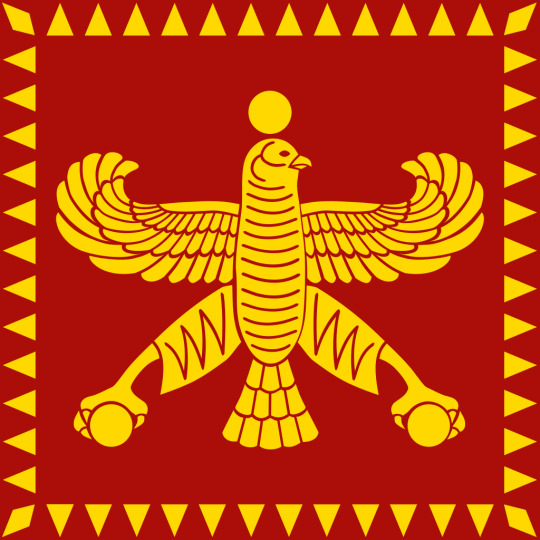
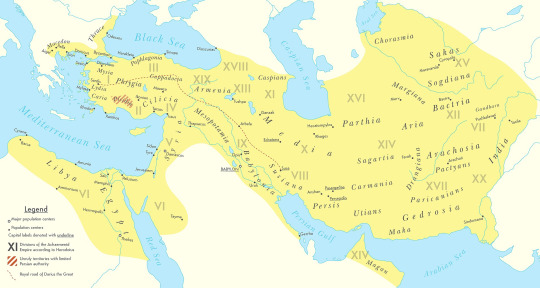


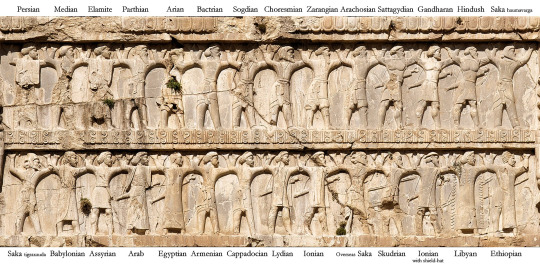
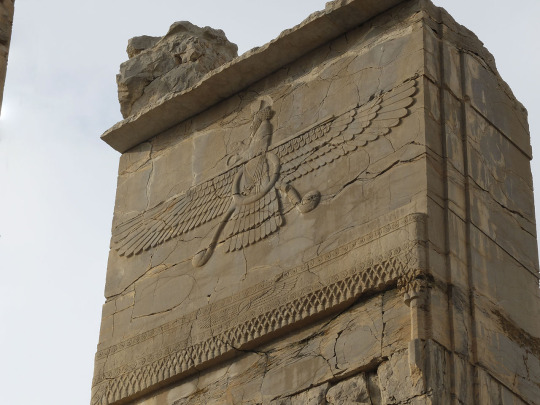




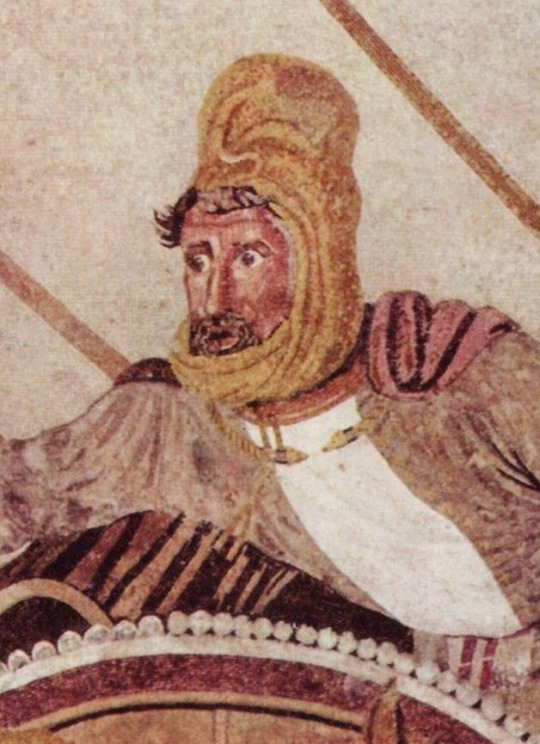
#military history#antiquity#iran#greece#ancient greece#classical greece#ancient ruins#ancient iran#ancient persia#achaemenid#persia#zoroastrianism#alexander the great#cyrus the great#xerxes#artwork#government#history#persian empire#ancient egypt
100 notes
·
View notes